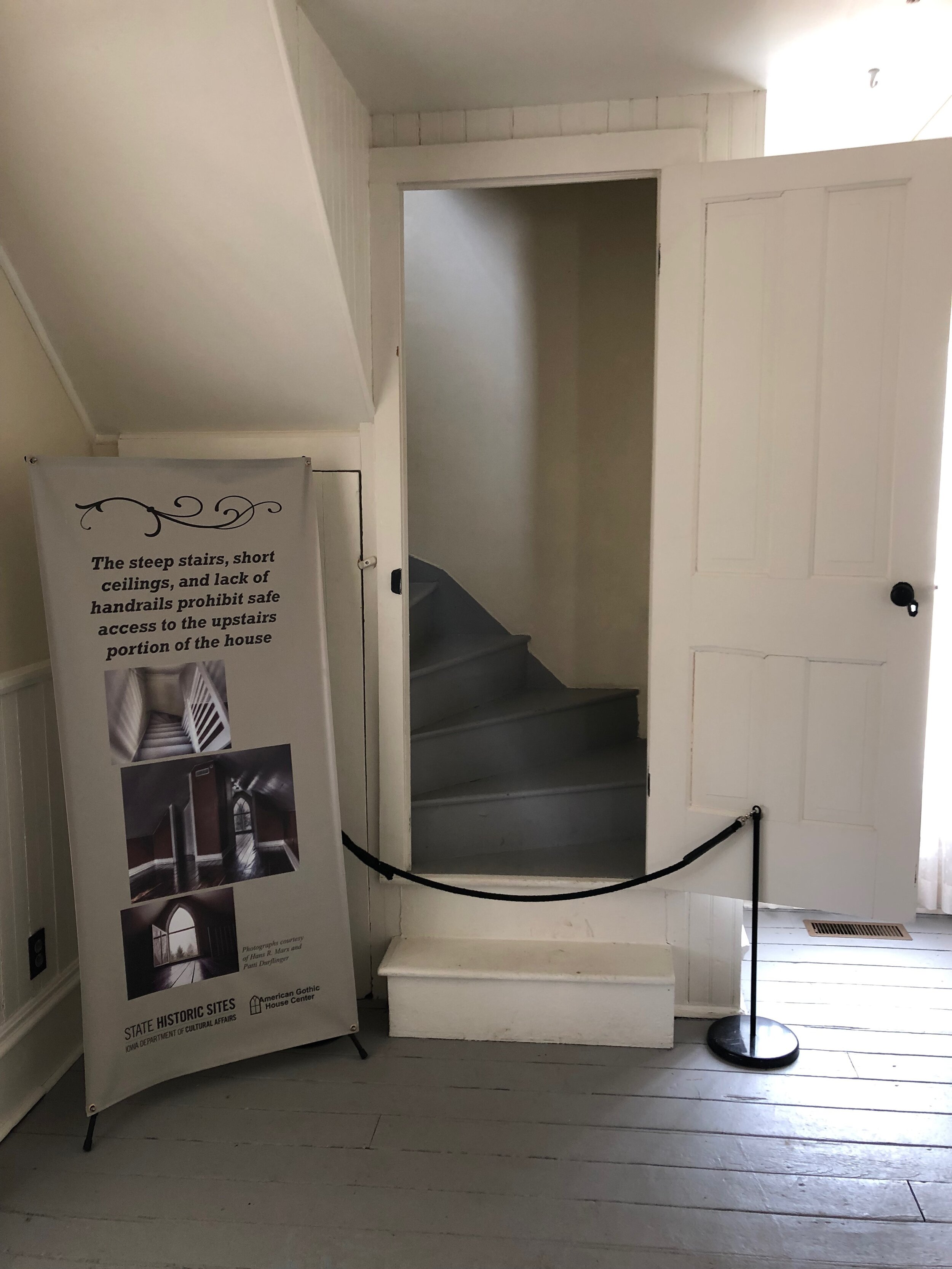History of the American Gothic House
(a.k.a. The Dibble House)
The American Gothic House in Eldon, Iowa is famous as the backdrop of Grant Wood’s 1930 painting, American Gothic. Since completion, the painting has become an American icon, and has been both the backdrop and the model for a countless number of parodies.
The original portion of the house that contains the two Gothic windows (one on the front of the house, one on the back) was built in 1881-82 by Catherine and Charles Dibble. Because of this, the house is listed on the National Register of Historic Places as the Dibble House. Mr. Dibble owned a livery stable in Eldon. It appears he later lost the house and it was sold for overdue taxes.
Over the years the house has changed hands with the owners either living in the house or maintaining it as a rental property. The State of Iowa is the current owner, acquiring it in 1991 when then-owner Carl E. Smith donated it to the State Historical Society of Iowa. From 1991 to 2014, SHSI continued to rent the house out, asking the tenants to also act as caretakers for the house in their absence (as they are based out of Des Moines, almost 2 hours away).
It was in the summer of 1930 that the famous house was first seen by Grant Wood. Wood was in Eldon for an art exhibition being done by Edward Rowan, who was the director of the Cedar Rapids Little Art Gallery. Rowan had taken a great interest in Eldon and believed that it was prime location to conduct an experiment in bringing art to remote rural areas. It is unclear why Rowan chose Eldon for his experiment, other than having an acquaintance from Eldon, John Sharp. Sharp was an art student at the University of Iowa and frequently went to the Little Gallery in Cedar Rapids.
Edward Rowan, 1934. Photo courtesy of the Smithsonian.
For whatever reason that Rowan picked Eldon, is was a surprise and delight to the residents as reflected in The Eldon Forum on July 31, 1930: “The people of Eldon and vicinity are to be given an unusual treat during the month of August by the establishing of a little art gallery in this city.”
The one-month long project featured exhibitions by a different artist each week, classes in drawing and watercolors for children, and music appreciation classes for older youth. Sharp’s parents served as one of the local hosts for the event known as the “Eldon Art Center.”
It was for one of these exhibitions that Rowan invited Grant Wood, who he became acquainted with through the Little Gallery, to the Eldon Art Center to give an exhibition. John Sharp, who knew Wood through Rowan’s art gallery, took Wood on a drive one afternoon where Wood spotted the house with the unique window. Upon sight, he asked Sharp to pull over so he could make a sketch. In later interviews, when asked why the house caught his eye, Wood said he found the window amusing and called it “pretentious” for such a small house. As he did with most paintings, he sketched his idea on site, but returned to his studio in Cedar Rapids to complete the work.
Sketch for “American Gothic” by Grant Wood, courtesy of the Smithsonian.
The great windows Wood saw at the American Gothic House were believed to be for a decorative purpose. However, upon further investigation and probably not known to Wood, the window is hinged and was used to move furnishings either into or out of the upper floor, as the inner stairway with its tight corner, is not suitable for moving large pieces of furniture such as a bed or dresser.
It is unknown why the Dibble family chose to include Gothic windows in the gables of their home. It is a common belief that the windows were purchased through the Sears and Roebuck catalog, but according to the Sears timeline, it seems more likely there was a railroad car full of this type of window that became available. Why they chose a window that is more associated with church architecture no one knows for sure. One thought is among the struggles of life and work, this was one way that the Dibbles were able to add a little beauty to their everyday lives.
Nan Wood Graham, the model for the woman in American Gothic and Wood’s sister, poses with Carl E. Smith, the owner of the house at the time, in front of the Dibble House, now known as the American Gothic House.
The use of the Gothic windows follows a mid-19th century trend know as Carpenter Gothic. The style grew out of a need for quickly built homes and a desire for fanciful details. The price to add fanciful details to wood-framed structures decreased significantly so that even the humblest homes were able to incorporate some extra beauty. Identifying features of Carpenter Gothic include steeply pitched roofs and gables, carved porch railings, strong vertical design elements, such as board and batten siding and of course, pointed-arch windows.
This beautifully crafted house still stands where it was first built. In the 1960’s and early 1970’s, there were discussions about moving the house to a more convenient location, but no action was taken. With its listing on the National Register of Historic Places (1974), the donation to the State Historical Society of Iowa by Carl E. Smith (1991), and the addition of the American Gothic House Center (2007), the house is secure in its original location.
Interior Photos of the American Gothic House
(Click to enlarge)
















